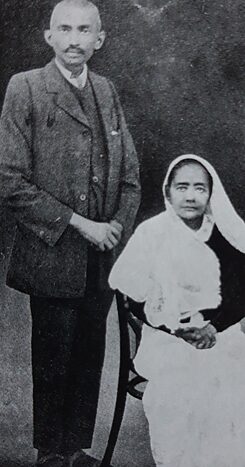by Bernard Imhasly
The Goethe-Institut / Max Muller Bhavan Mumbai and Paramparik Karigar celebrate the 150th Birth Anniversary of M.K.Gandhi. Paramparik Karigar is an Association that provides craft practitioners with access to market opportunities and design innovations, thereby strengthening the sustainability of the various craft traditions of India. A series of talks through October 2, 2020 will highlight the close association of Gandhi with these traditions. The initiative begins with a talk by Bernard Imhasly at the library of Goethe-Institut / Max Mueller Bhavan Mumbai on January 20, 2020.
Stitching together a nation:
Gandhi’s use of textiles to forge a common Indianness
 Mahatma and Kasturba Gandhi shortly before leaving South Africa (1914)
| © Bernard Imhasly
The Khadi Campaign remains the cornerstone of Gandhi’s non-violent strategy, combining economic boycott and self-reliance with a visible – wearable – symbol of a common nation.
Mahatma and Kasturba Gandhi shortly before leaving South Africa (1914)
| © Bernard Imhasly
The Khadi Campaign remains the cornerstone of Gandhi’s non-violent strategy, combining economic boycott and self-reliance with a visible – wearable – symbol of a common nation.
Underlying this strategy is Gandhi’s uncanny awareness of the symbolic potency of cloth and dress, embedded in a common culture.
The talk looks at Gandhi’s attempt to build a widely understood cultural vernacular, by using textiles as a symbolic expression of both diversity and commonality.
It is then argued that the success of this campaign points to a deep-rooted common understanding of the symbolic, if not spiritual, value of cloth and dress.
About Bernard Imhasly
He is a Swiss journalist and author, based in India since 1984. In 2006 he wrote the book ‘Goodbye to Gandhi? Travels in the New India’ (Penguin, 2006).
Back